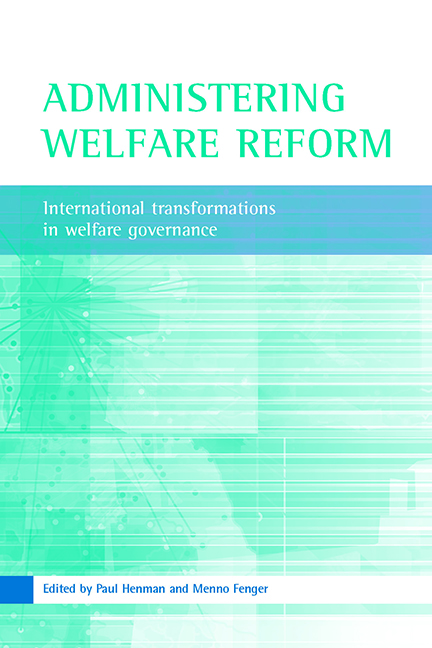Book contents
- Frontmatter
- Contents
- List of tables
- Preface
- Acknowledgements
- List of abbreviations
- Notes on contributors
- one Introduction: administering welfare reform
- two Welfare reform as governance reform: the prospects of a governmentality perspective
- Part One Participants: reforming the agents of welfare delivery
- Part Two Practices: the welfare governance of street-level practices
- Part Three Processes: the changing spaces of welfare governance
- Index
- Also available from The Policy Press
one - Introduction: administering welfare reform
Published online by Cambridge University Press: 14 January 2022
- Frontmatter
- Contents
- List of tables
- Preface
- Acknowledgements
- List of abbreviations
- Notes on contributors
- one Introduction: administering welfare reform
- two Welfare reform as governance reform: the prospects of a governmentality perspective
- Part One Participants: reforming the agents of welfare delivery
- Part Two Practices: the welfare governance of street-level practices
- Part Three Processes: the changing spaces of welfare governance
- Index
- Also available from The Policy Press
Summary
After a century of relatively unchallenged growth of the welfare state, the last decade of the 20th century marked the start of the era of welfare reform. The Reagan and Thatcher administrations appeared to be among welfare reform's frontrunners in the 1980s, but throughout the remaining years of the 20th and the start of the 21st century, welfare reform has been a prominent item on the agenda of almost every government in the modern democratic capitalist world. Among the developments that are said to have triggered welfare reform processes are economic globalisation, the development of new (information and communication) technologies, changing household structures, population ageing and the position of women (see Taylor-Gooby, 2005). There seems to be a wide variation in the directions of welfare reform processes: decreasing the level of benefits; adjusting eligibility rules for programmes; reforming or ending programmes; changing the institutional setting of programmes; and increasing efforts to activate the unemployed are all examples of various governments’ efforts to cut back on welfare expenditures that can be united under the ‘welfare reform’ label.
Causes and consequences of welfare reform and the policy details of welfare reforms have been dealt with quite extensively by a large amount of scholars from all over the world, especially within European and North American contexts (see, for instance, Esping-Andersen, 1996; Pierson, 2001a; Taylor-Gooby, 2005). However, the practical side of welfare reform – namely transformations in the administration of welfare – seems to have received somewhat less attention. This book provides such a much-needed overview through comparative studies of the way welfare reform has been implemented in various countries and the participants that have been involved. The book focuses on the under-studied areas of the changing institutional participants of welfare administration and practices of administering and managing welfare delivery. It is these aspects of welfare reform that complement studies of welfare reform policies, causes and consequences, that is increasingly being recognised as important to understanding the full nature and effects of welfare reform. The goal of this book is to give greater prominence to the administration of welfare reform as a way in which to understand and assess the range of effects of welfare reform on welfare claimants, staff and agencies. In doing so, we advocate a more extensive understanding of policy than is often the focus of analysis, one that sees policy as practice.
- Type
- Chapter
- Information
- Administering Welfare ReformInternational Transformations in Welfare Governance, pp. 1 - 18Publisher: Bristol University PressPrint publication year: 2006



